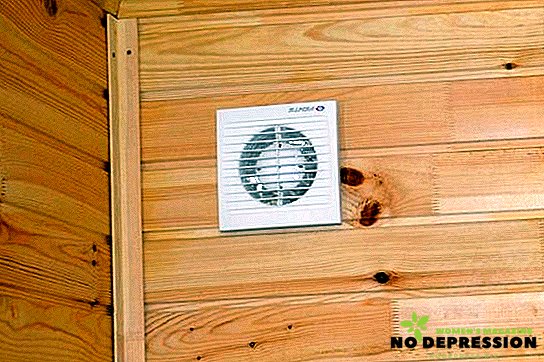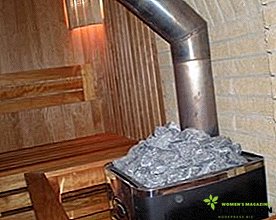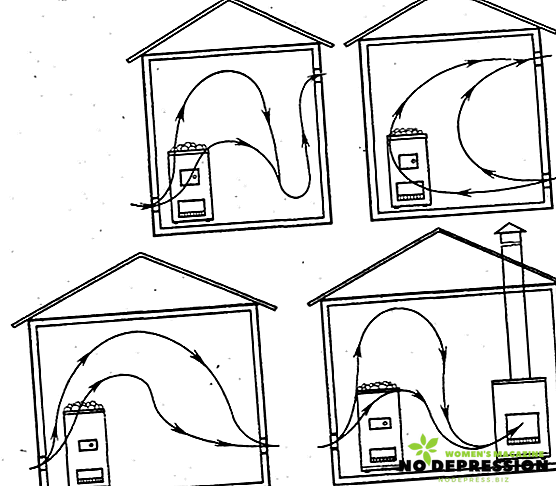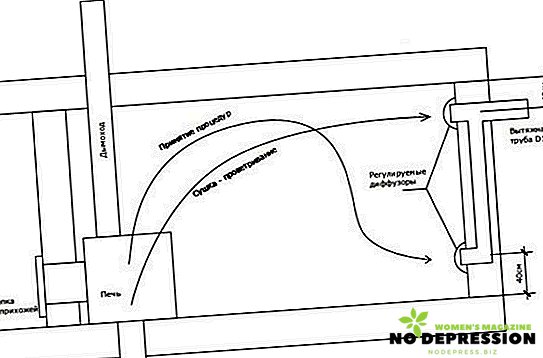When arranging a bath, it is very important to create high-quality ventilation - without normal air exchange, it will be impossible to conduct bath procedures, and the structure itself will begin to “suffer” from increased humidity, fungus and mold. Moreover, it is possible to equip the ventilation system with your own hands - you just need to choose the appropriate scheme.

What is ventilation for?
Is it necessary to triple the ventilation in the bathhouse or can you do without it? The functions of the ventilation system in such a room are further complicated by the fact that they have to remove moist air from the bath as quickly as possible and regulate the temperature.
This system is especially important for baths that are equipped with furnaces (gas or solid fuel), which will help maintain the process of normal combustion in such structures - they constantly require air flow.
In the absence of a ventilation system, an excessive concentration of carbon dioxide will be observed, which will adversely affect human health - if you stay in such a room for a long time, you can simply lose consciousness. Many novice masters, on the contrary, try to seal all the gaps, which, in their opinion, will increase the heating rate and retain heat indoors for a longer period.
This approach is fundamentally wrong - in the bath there must be at least minimal ventilation, which will allow:
- maintain a healthy microclimate;
- reduce the level of humidity;
- remove carbon dioxide from the room;
- minimize the risk of fungus and mold.
That is why the ventilation device is an important step in arranging a bath.
Important system planning nuances
Before proceeding to the arrangement of ventilation, you should find out some important nuances that will help you to carry out work with better quality:

- The system must be designed and laid during the construction of the bath: the installation of the required channels, openings.
- Adjustable windows are placed after covering the room. In order not to be mistaken in the construction, you need to specify them when creating the project.
- Ventilation openings must be the same size. But if you want to speed up the exhaust air, the exhaust port should be slightly larger than the flow-through.
- At the ventilation windows must necessarily be doors or valves, the latter option is more preferable, because the valves are closed more tightly.
- When calculating the area of the window, it is necessary to rely on the size of the bath - there is a norm, that a window with an area of at least 24 square centimeters is needed for 1 cubic meter of space.
- The openings should not be located opposite each other and be at the same level - in this case there will be no normal air circulation.
Main types of systems
Natural
Its principle is based on the application of the pressure difference inside and outside the room. It is considered the simplest, but not the most efficient, although many baths will equip this system with a low price.
Placement of ventilation windows should be determined based on the size of the room, the location of the rooms, the material of the bath. Whichever scheme you choose, there is one general rule - the holes should be located at a height of about 30 cm from the floor level, the exhaust hole should be at the same distance, but from the ceiling level. The dimensions of the outlet should be about 30-40 cm square.
It is worth remembering that this type of ventilation is not suitable for arranging a steam room.
Forced
In this case, the movement of air masses is carried out by installing special fans. This option is suitable for those who install steam generators in the room. Among the advantages of such a system are:
- the ability to filter incoming air;
- microclimate maintenance;
- uniform distribution of heated air.
In order for the bath to receive the necessary volumes of air, the ventilation holes must be diametrically placed. However, when installing the fans, it is not necessary to place the vents at the same level, this will prevent the closure of air masses.
Floor ventilation
When arranging a steam room, it is advisable to pay attention to the floor ventilation system, since in such rooms the floors are operated in the most difficult conditions. With proper ventilation, it is possible to remove excess steam and eliminate the risk of fungus and mold.
When arranging the system should be remembered that:
- it is necessary to equip the system when drawing up a bath scheme before its construction;
- climate, landscape, sources of pollution must be taken into account when planning the location of ventilation openings.
Most often such vents are located on three levels: under the flooring, at the level of the heating structure and in the walls at a distance of 40 cm from the floor level.
How to make ventilation
Before you start work, there are a few things you should not forget about. So, the exhaust system should not:
- cause disturbances in the temperature regime in the bath;
- cause cold air to rise to the ceiling;
- remove fresh air from the bath.
Some principles of creating such a system also depend on the architectural features of the building. For example, if there are gaps in the floors for the discharge of water, fresh air can also flow in through them, as a result, there is no need to make exhaust openings. If the heater of the heater is located directly in the room, then it will act as an exhaust: simply open the chamber and adjust the air exchange with the help of the flap.
For frame bath
In the baths of this type of natural ventilation will be absent due to the presence of a large number of insulating materials. In this case, it is necessary at the construction stage to provide for the installation of an opening with a flap. The most effective system for a frame bath is a forced-air exhaust system, in which you need to equip two channels: one should be located near the floor (for air flow), the second at a certain distance from the ceiling (air outlet). The openings themselves must be equipped with special valves that can be adjusted.
In the Russian bath
For the Russian bath does not fit forced air circulation - here you need to use the natural system. Adhere to the following rules when arranging a bath:
- it is necessary to provide for the presence of windows, openings;
- the upper boundaries of the doors and windows should be on the same level;
- for high-quality air exchange, it is necessary to equip an air inlet near the heater, equipping it with a damper, and an exhaust hole - it should be located under the ceiling.
The construction of a quality system is very important for such rooms, since the presence of excessive moisture can cause a negative impact on the wood, as a result of which mold and fungus can appear.
Bastu
In the past few years, modern and unusual solutions have been used in the creation of ventilation systems. For example, ventilation Bastu, which enjoys great popularity among domestic builders due to its simplicity, is quite an adequate price and efficiency. To equip such a system with your own hands, you need to take into account some of the nuances:
- The red-hot stove acts as a heat pump, pulling in clean air from the intake duct.
- Cold streams will pass through the furnace, quickly heating up and rising to the ceiling, pushing the near-field air in an equal volume through the exhaust channel.
To equip such a system, you will need two stainless steel pipes - the lower one should be mounted at a height of about 20 cm from the heater and the floor, the second should be located above the stove itself. All outlets of ventilation systems must be equipped with special valves.
The truth is to remember that the natural ventilation system Bast can function only in two cases: a working stove or a strong wind.
Walkthrough
To create a high-quality system with your own hands, you must perform the following steps.
Schema selection
The choice of the scheme depends largely on the material of the design, the method of drawing - whether the ventilation is natural or forced. For example, according to the laws of physics, the air inlet should be below the exhaust, but there are other options for schemes:



Choosing the path of ventilation flows
This moment is very important that after the construction in the bath the effect of "reverse ventilation" is not created. This can happen if you do not take into account the strength and direction of the wind. For example, the exhaust opening goes to the side where strong winds usually blow. In this case, air will get into the exhaust port, the intake air can also change its direction.
Therefore, it should be oriented as follows: the inflow inlet should be located on the side of a strong wind, and the outlet should be on the opposite side; you can also bring the pipe through the roof.
Creating holes and installing pipes
To create an air duct it is best to use galvanized pipes. If you decide to take plastic, you should pay attention to the temperature range - if they are designed for use at low temperatures, then in the steam room products will become unusable.
After creating holes in the walls, the space between them and the pipe should be laid with a heater, for example, mineral wool, the gap itself should be filled with mounting foam. When it is dry, install ventilation grilles on the screws and check the operation of the system by bringing smoking paper to the hole. If you want to provide forced ventilation, just install a fan.












